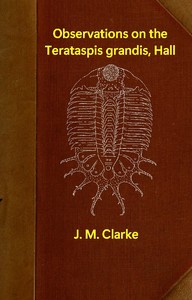| Author |
Clarke, John Mason, 1857-1925 |
| Title |
Observations on the Terataspis grandis, Hall, the largest known trilobite
|
| Original Publication |
United States: None Listed,1891.
|
| Credits |
Tom Cosmas produced from images provided by The Internet Archive and placed in the Public Domain.
|
| Summary |
"Observations on the Terataspis grandis, Hall, the largest known trilobite" by J. M. Clarke is a scientific publication written in the late 19th century. This work primarily discusses the Terataspis grandis, the largest known species of trilobite, exploring its anatomy, ecology, and potential size based on fossil records. The book presents a detailed analysis of the trilobite's physical characteristics and references other large trilobite species while contextualizing Terataspis grandis within the broader geological history of trilobites. The content of the book revolves around the exploration of the Terataspis grandis as a significant specimen within the trilobite family. Clarke delves into descriptions of various large trilobite species, citing historical references and providing comparative data to illustrate the impressive size and anatomical structure of the Terataspis grandis. He discusses fragments found in New York and Ontario, explores the implications of these discoveries for understanding trilobite evolution, and proposes a restoration of the creature that suggests it could have reached lengths of up to 24 inches. This work serves as an important contribution to paleontology, particularly in its emphasis on the size and adaptability of prehistoric life forms. (This is an automatically generated summary.)
|
| Language |
English |
| LoC Class |
QE: Science: Geology
|
| Subject |
Trilobites
|
| Subject |
Paleontology -- New York (State)
|
| Category |
Text |
| EBook-No. |
67196 |
| Release Date |
Jan 19, 2022 |
| Copyright Status |
Public domain in the USA. |
| Downloads |
56 downloads in the last 30 days. |
|
Project Gutenberg eBooks are always free!
|

